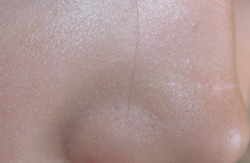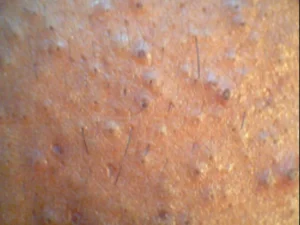Even we admit, it can be hard to tell these two apart sometimes! But they are different and usually require different forms of treatment to clear them up. This is why self-diagnosis or self-treatment can be risky. If you treat one as the other or vice versa, you can make things worse.

Let’s start with milia. These are small, pinpoint white bumps that usually pop up on the oily areas of the face. They will come and stay, and sometimes, you feel them more than see them. They happen when dead skin cells become trapped beneath a few cell layers of the skin. In essence, they are very small cysts and completely harmless. Pretty much anyone can get them—and up to 50% of newborns have milia! They are also common in kids, teens and adults. If you have an oilier skin type, then you may be more prone to developing milia, but it’s important to note that it is not a form of acne or related to acne.
Treatment revolves around a couple different things. Number one, you should control your oil. This is easily done with skin care products that contain either glycolic acid or retinols. This will help you prevent milia. But what about the milia that are already there? The most common way to get rid of them is to “extract” them. This involves opening the milia and getting the clump of dead skin cells out. While it seems straight forward, it can be tricky and we’ve seen several instances where extractions done by both patients and aestheticians resulted in icepick type acne scars because they were too aggressive. An alternative treatment is the use of q-switched lasers combined with topical products to remove milia. This is generally very safe and results in good clearance.

Now, onto acne. There are few different forms of acne and most people who suffer with it have a mix of these forms: comedones, papules and/or nodules and cysts. It is the comedonal form of acne that is most often confused with milia. Specifically, closed comedones. What’s the difference? A closed comedone is often referred to as a “whitehead” because it is a plugged oil gland that is not inflamed, but is covered by a thin layer of skin cells that protects it from contact with the air. The other is an open comedone or a “blackhead”. It is the exactly the same as an open comedone, but the difference is that there is no covering so it is exposed to contact with the air. This changes the sebum (oil) that’s in the plug and makes it turn dark or “black”.
Treatment of comedonal acne is first and foremost dependent on a strict regimen of good skin care. Again, glycolic acid containing products or retinols work well to control the oil, and they also help gently exfoliate to dislodge the plugs in the oil glands. If used daily, this often clears up most open and closed comedones. A good jump start or a more intensive treatment can also include chemical peels to further encourage exfoliation. It is important to NOT extract comedonal acne lesions as this can lead to scarring and aggravation of inflammatory acne.
Another alternative treatment is laser therapy for acne. Light based treatments can help curb bacterial growth that is associated with acne. There are also treatments designed with light and light sensitizing medication that can help dry up oil to improve stubborn, resistant acne.
As you can see, it’s important to distinguish which of these two, often confused conditions you have, because treatments vary. The key to any successful treatment plan is correctly identifying what it is that your treating in the first place!

